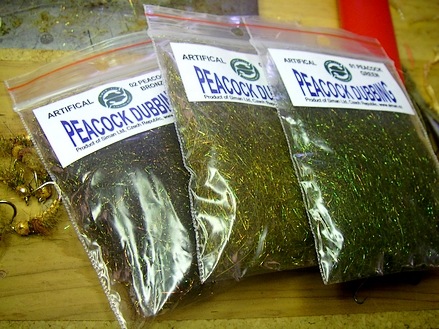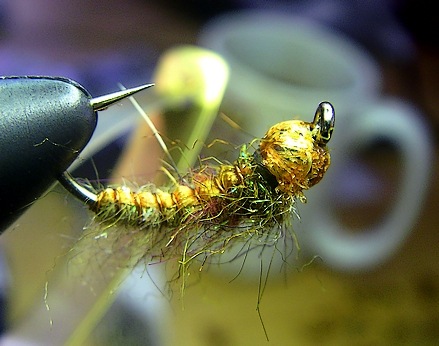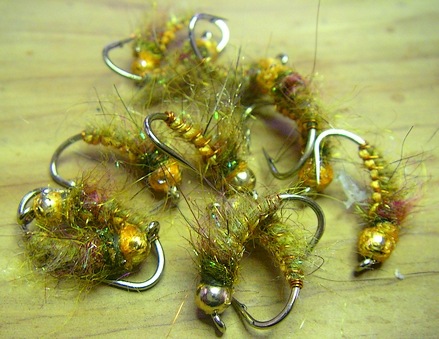In Spring a young man’s thoughts turn to love – and in Fall, us mature types think of love too, how much we’d love it to be cooler…
I’m tired of dusty creeks and the rattle of discarded water bottles blowing in the hot breeze. We’ve endured enough fires, sweltering mornings, and fleeing to the safety of air conditioning before noon.
October usually offers the first real respite from Summer’s heat. After three years of drought and yet another fortnight of blazing days I’m ready for mornings chill and the tinkle of something other than broken glass.
I’m going to will a change in the weather, if only by the flies tied.

Jan Siman’s Peacock dubbing showed Friday, which had me scratching my chin. It’s a different cut of Angelina fiber that I’ve not seen before – akin to the the soft crimp but with straight fibers rather than crinkled.
The straight fiber offers a much rougher dubbing than traditional soft crimp Angelina fiber, consistent with the dubbing-brush-rough-combed look of most Czech nymphs. I’ll investigate this style with the vendor to see if there isn’t something new in the offing.
Comparatively speaking, the Peacock dubbing package is about a quarter the size of a traditional pack of dubbed fur – and the declining dollar versus the Euro adds to the $4.25 price burden. Beautiful colors useful for much more than Czech nymphs – but I was caught up in a new yarn, a yen for cooler temperatures, and the Fall Big Bug, the October Caddis.

It’s a mixture of new materials; using the lace component of a new trilobal yarn I unearthed, mixed with a gold and brownish-burgundy blended fur and topped with some of the Peacock dubbing.
Tied upside down so the the lace is on top once the fly flips over. The Orange lace extends over the bead and is tied on the opposite side. This gives the gold 4mm bead an orange effect, and dulls the shine quite effectively. You can see the raw gold versus the yarn-draped color in the picture shown below.

Comb out the underside a bit to offer a hint of leg, and start praying for colder weather and fish with an appetite.
Tags: Jan Siman’s Peacock dubbing, Angelina soft crimp, Angelina fiber, fly tying materials, October Caddis, Czech nymphs, fly tying

wow, even an old guy still has a few tricks up his sleeve. I love the orange peel effect. That’s ballsy man.
I need to get a good luck at that dub; you think the EU has lifted the trade embargo on the roughfisher yet?
So, do you tie in the yarn along the bottom, then just lay it back over the dubbing (then rib it with the wire)?
Also, did you rough up those gold beads? They look pretty scratched up – or maybe that is the reflection of the dubbing in it?
Nice looking flies – and the dubbing looks pretty cool.
@Roughfisher – they take their Carp seriously, and while the trade embargo has been lifted you’ll still need an environmental impact report to sling your tungsten…
@Brandon – I tie the entire fly upside down. The yarn is tied in first with the copper rib then yanked over the fly and bound at the end.
The gold beads are wrapped with the yarn – which is a very fine woven lace. I push the hook eye through the lace, pull it down around the bottom half of the bead and tie it off under the fly (as I’m tying the fly upside down, “under” is actuall the top.)
The lace masks the shiny gold bead and adds an amber tint.
Pingback: How to extinct the San Juan Worm without half trying | Singlebarbed